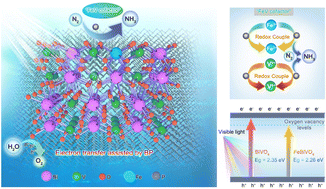“FeV-cofactor”-inspired bionic Fe-doped BiVO4 photocatalyst decorated with few-layer 2D black phosphorus for efficient nitrogen reduction†
Abstract
Drawing inspiration from the biological nitrogenase mechanism, bionic photocatalytic nitrogen fixation technology plays a significant role in activating nitrogen molecules and promoting the nitrogen reduction reaction. However, developing effective semiconductor photocatalysts remains a considerable challenge in the field of bionic nitrogen fixation. Herein, a novel bionic “FeV-cofactor” system for performing photocatalytic nitrogen reduction was proposed for the first time based on an Fe-doped BiVO4 photocatalyst decorated with few-layer 2D black phosphorus (BP). As expected, Fe doping and BP decoration significantly improved the NH3 yield of BiVO4. With an NH3 yield of 337.9 μmol g−1 h−1 (6.83 times that of BiVO4), FeBiVO4-0.05BP ranks among the top-performing nitrogen-fixing materials in oxide-based photocatalysts. DFT calculations show that N2 molecules can be adsorbed and activated by Fe doping, thus forming the in-built bionic “FeV-cofactor”. The experimental results further confirm that introducing a bionic “FeV-cofactor” system enhances the electron transfer between redox couples (V5+/V4+ & Fe3+/Fe2+) and N2, thus improving the carrier separation efficiency. Oxygen vacancies coupled with V4+ ions also contribute to increasing light absorption. The 2D BP decoration plays a crucial role in the whole process of nitrogen reduction due to its exceptional electron transfer ability while increasing the active sites of the reaction.

- This article is part of the themed collection: Nitrogen-cycle electrocatalysis


 Please wait while we load your content...
Please wait while we load your content...